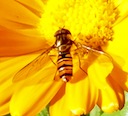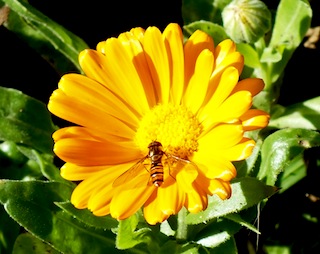 The Marmalade Fly, our most common hoverfly, can be seen most of the year, as overwintering adults will emerge on sunny winter days.
The Marmalade Fly, our most common hoverfly, can be seen most of the year, as overwintering adults will emerge on sunny winter days.
Photo: Amanda Scott
Scientific name: Episyrphus balteatus
What to look for:
- Colouring: Orange and black abdomen, each segment having two black/dark bands separated by two orange bands.
- Size: Length 10 mm
- When: Peak of abundance is in July, but can be spotted all year.
- Where: Across the UK
 The Marmalade Fly is the commonest hoverfly in Britain. Not only is it widespread across the whole of Britain but, although its peak abundance is usually in July, it can be spotted at any time of the year. This even includes winter. The Marmalade Fly hibernates through the colder months, but will rouse to feed on sunny days. Its full range covers Europe, northern Asia and northern Africa.
The Marmalade Fly is the commonest hoverfly in Britain. Not only is it widespread across the whole of Britain but, although its peak abundance is usually in July, it can be spotted at any time of the year. This even includes winter. The Marmalade Fly hibernates through the colder months, but will rouse to feed on sunny days. Its full range covers Europe, northern Asia and northern Africa.
Like many other hoverflies, the Marmalade Fly is a wasp mimic. Harmless itself, its colouring mimics solitary wasps, and therefore deters potential predators. It is relatively easy to identify, with its distinctive abdomen pattern of thick and thin dark bands against an orange background. It is quite variable though, depending on the temperature experienced by the developing larvae. In hot conditions, larvae become more orange adults, and in cold conditions, the larvae become darker adults. In extreme cases, adults may be completely orange or completely black.
Adults feed on nectar and pollen from flowers (it is one of only a few fly species that can crush and eat pollen grains), and the larvae help out gardeners by feeding on aphids, usually at night: each larva can eat over 200 aphids during their development. They are important to agriculture too: larvae are a natural biological control agent for aphids on cereal crops, and the adults are crop pollinators.
When seeking mates, the males claim a territory, and hover over it to attract females and deter other males from approaching. Females lay their eggs in vegetation, usually close to existing aphid colonies so that the larvae have a ready food source after hatching. Eventually, a larva’s skin will harden and it will pupate before emerging as an adult.
There are over 280 species of hoverfly in Great Britain, many of which (though not all) are characterised by their highly recognisable bright yellow and black patterning, mimicking wasps and bees (known as Bartesian mimicry) and therefore, although harmless, deterring predators. Their ability to hover in flight, either when nectaring or, in males, when searching/waiting for a mate, is also a very familiar feature.
Did you know…?
…Globally, there are some 6000 species of hoverfly in 200 genera
…We occasionally see large influxes of migrating Marmalade Flies from Europe in the summer, caused by population build-ups on the continent coupled with favourable winds and weather for migration. These influxes can cause alarm, due to the species resemblance to wasps.
More information and references:
Ball, S. and Morris, R., 2013. Britain’s Hoverflies: An Introduction to the Hoverflies of Britain. Princeton University Press, Woodstock, Oxfordshire.
Chinery, M., 2005. Collins Complete Guide to British Insects. HarperCollins, London.
Published: October 2014
Author: Amanda Scott
Photos: Amanda Scott
